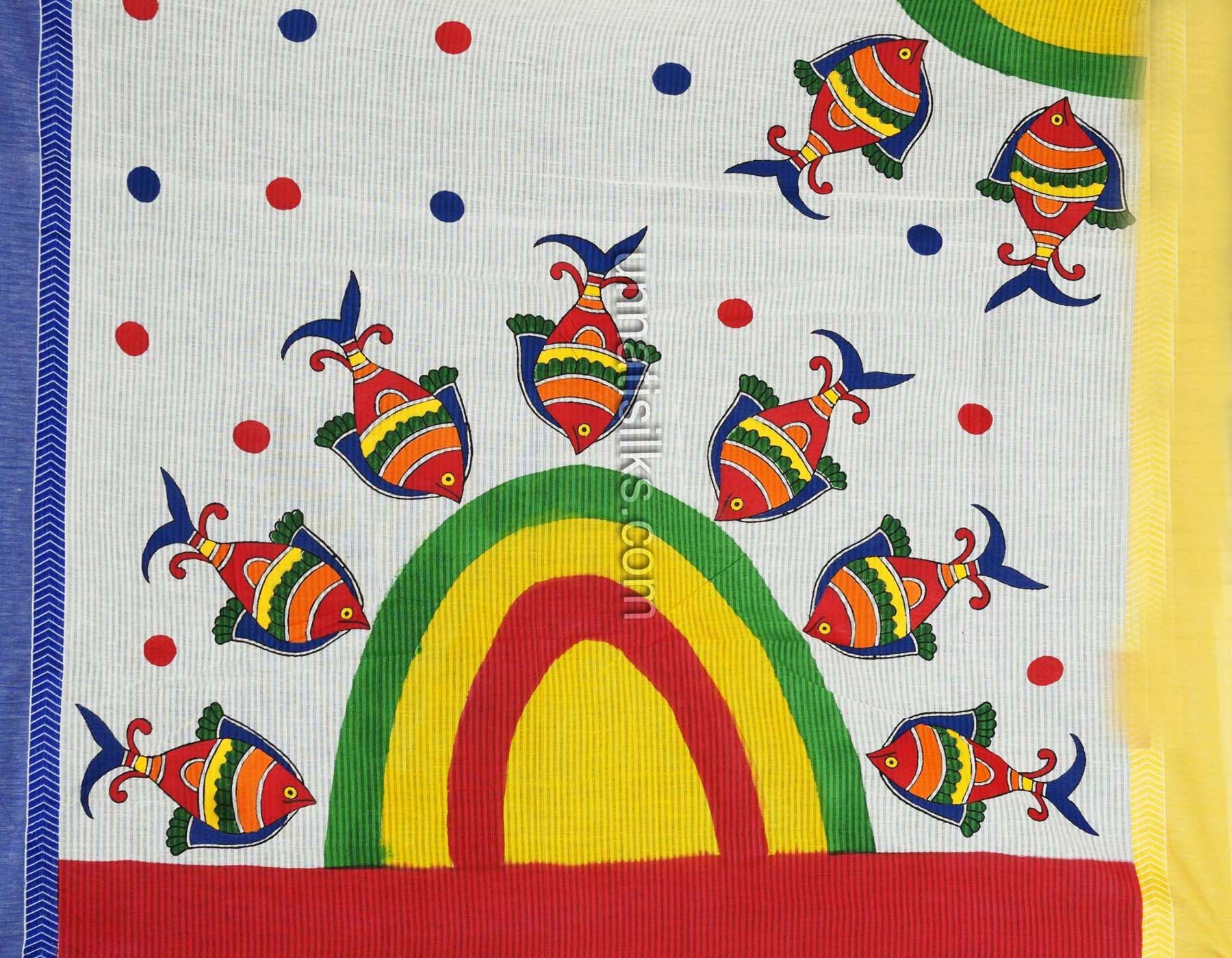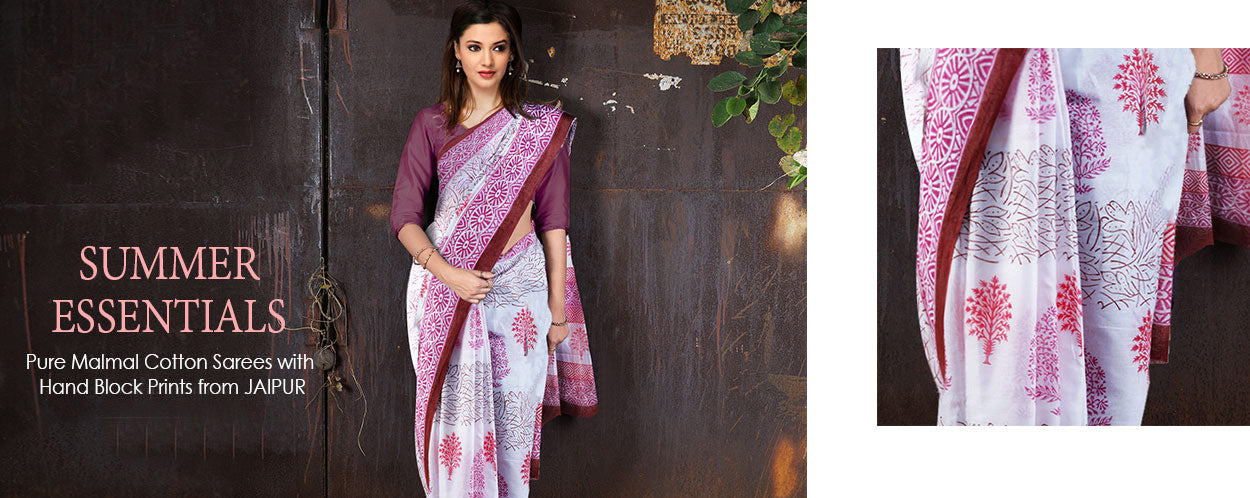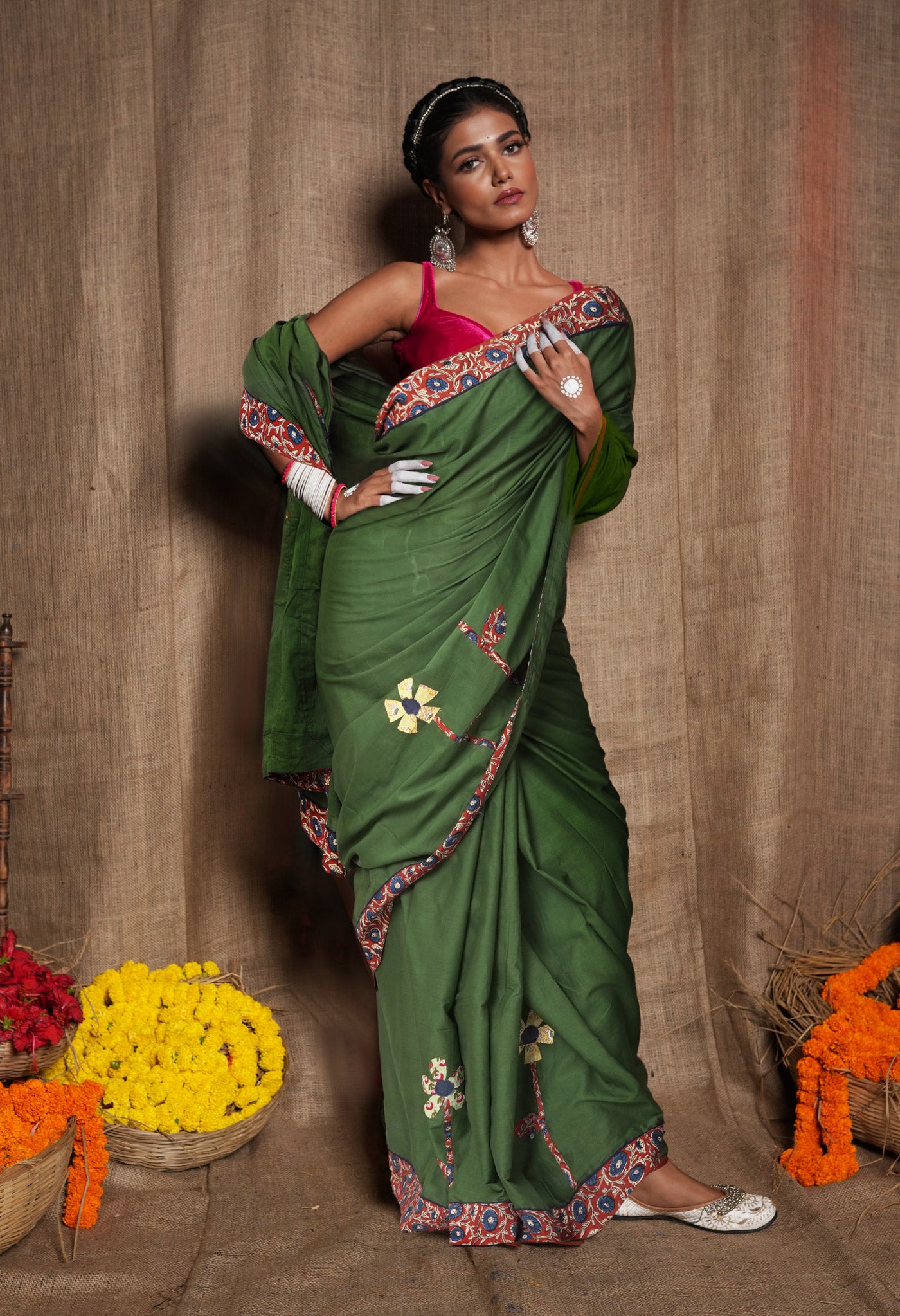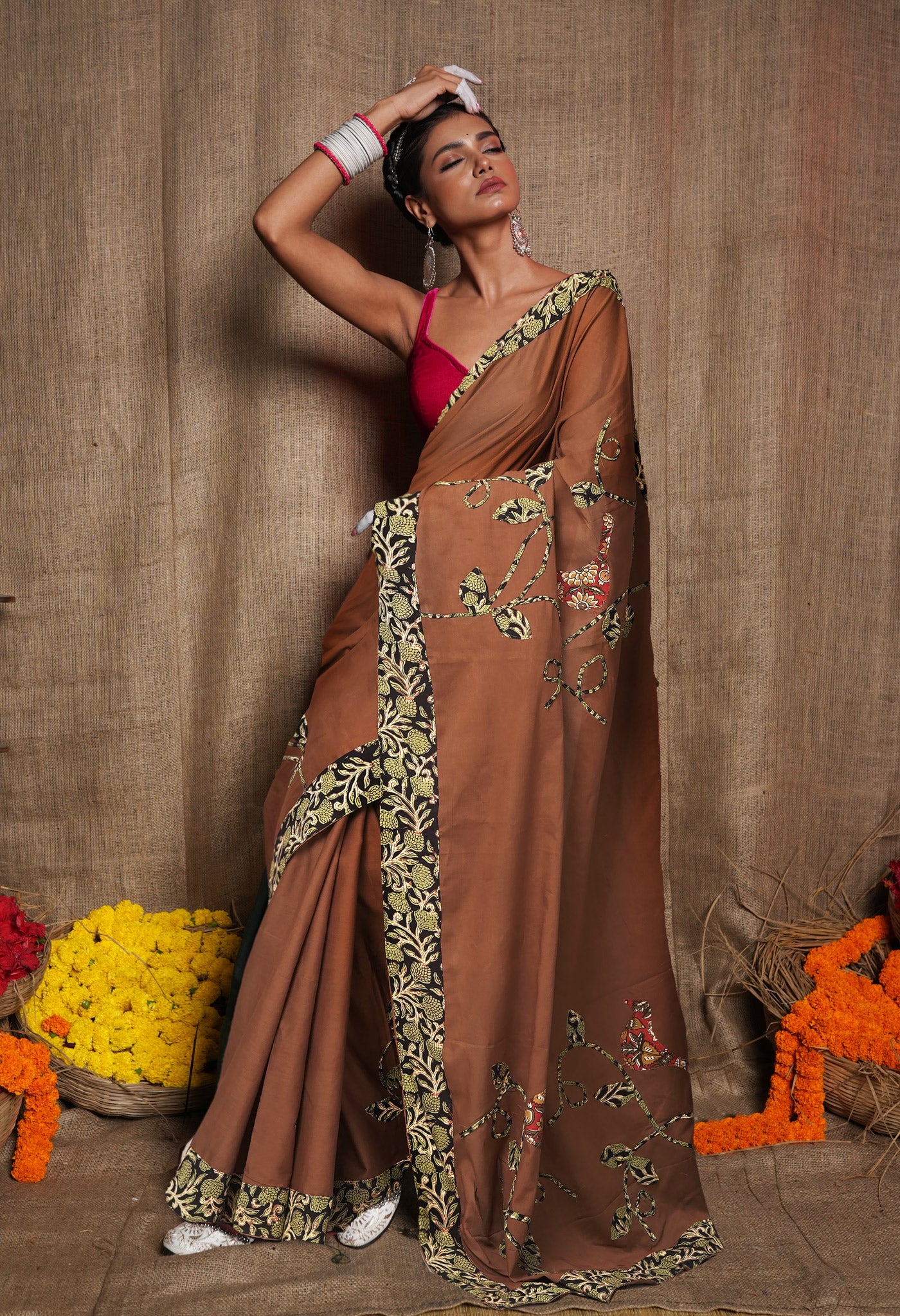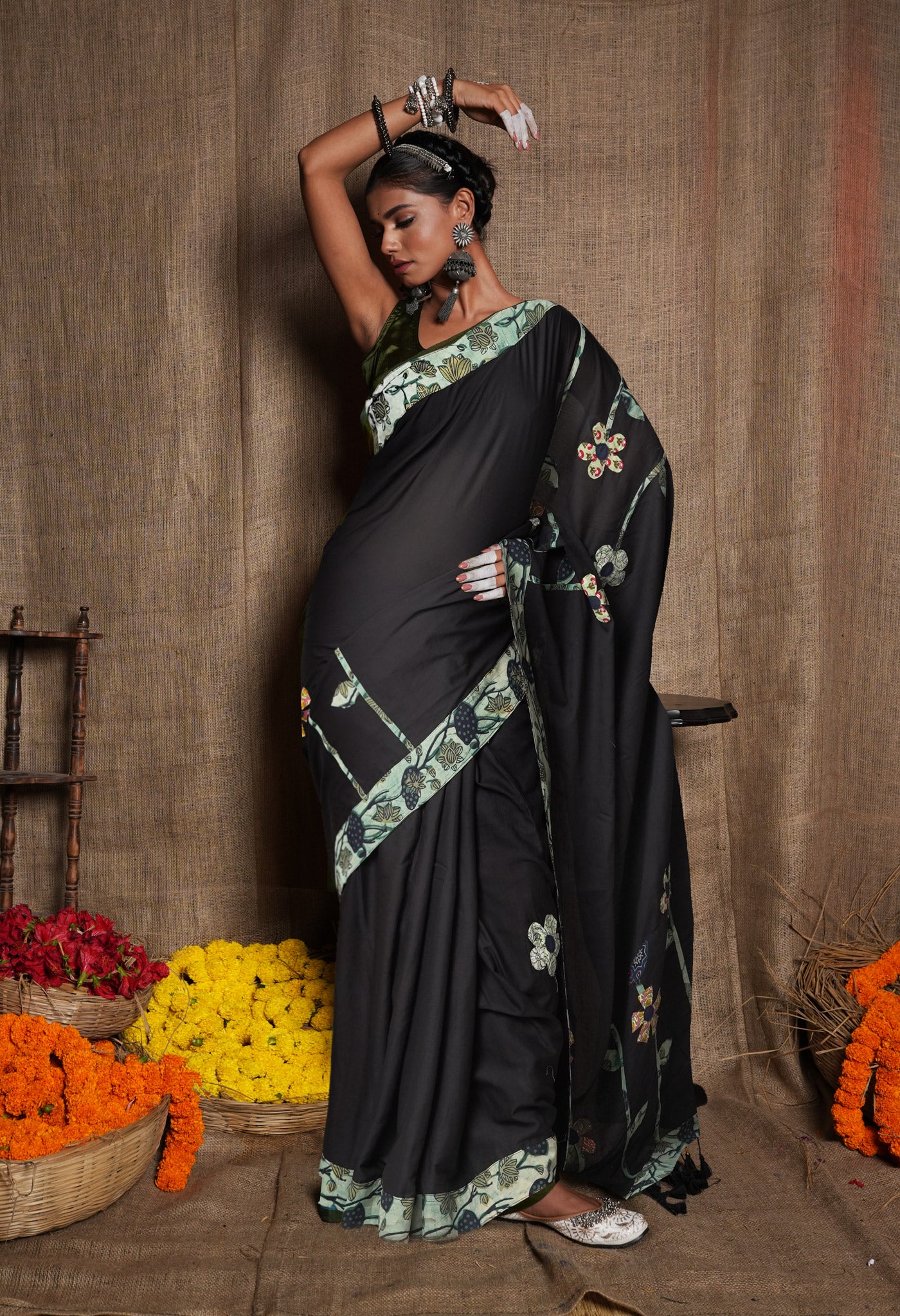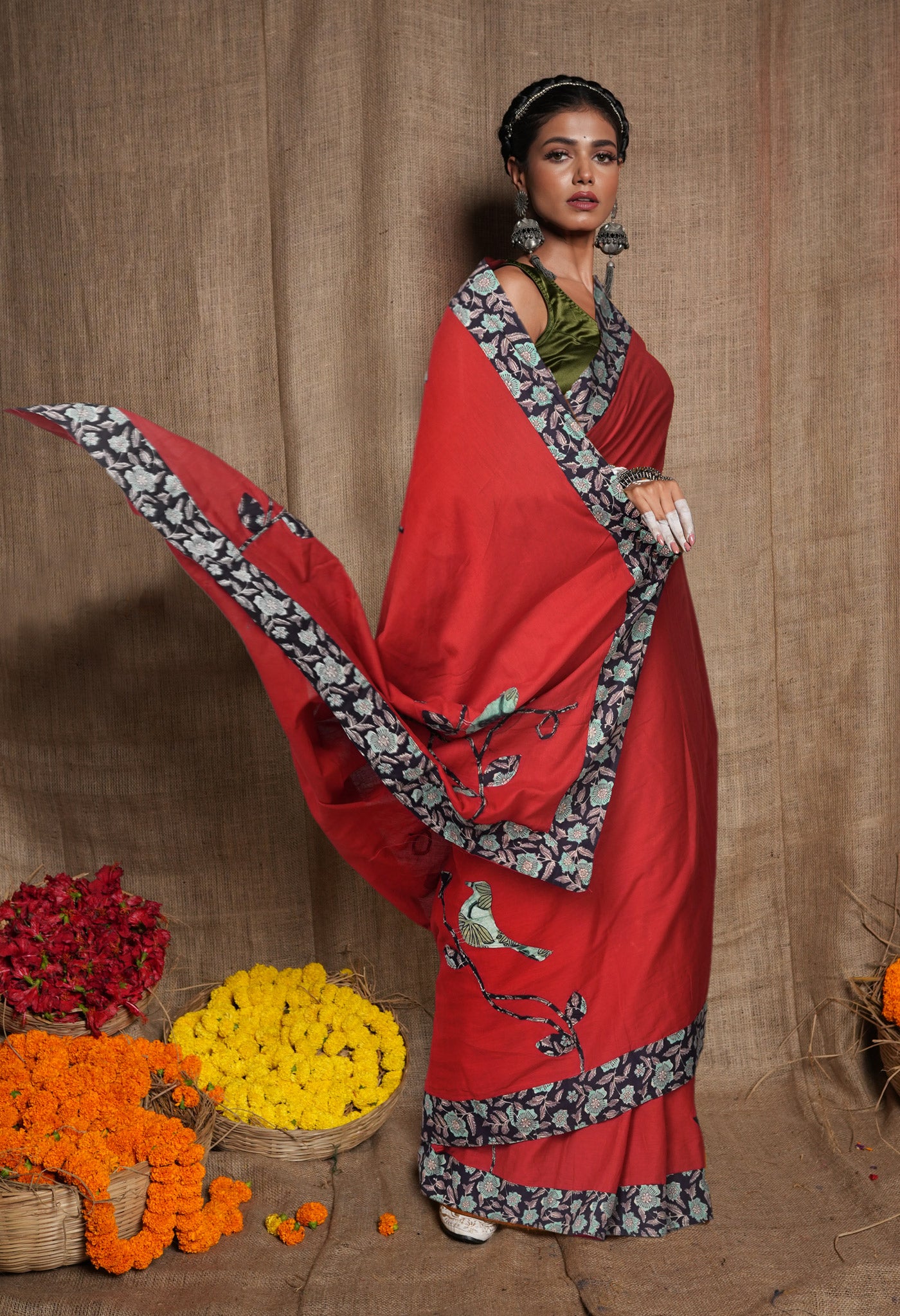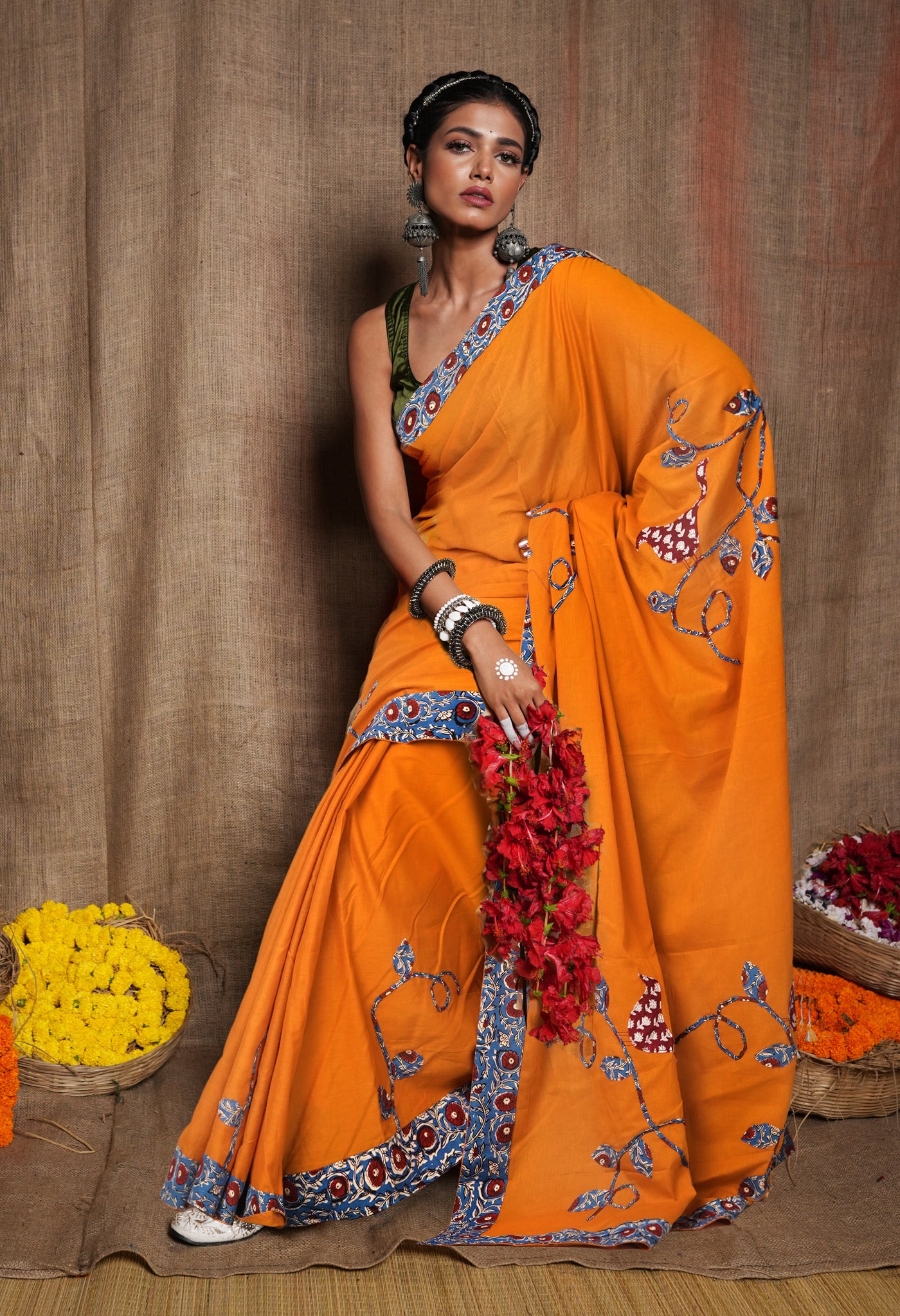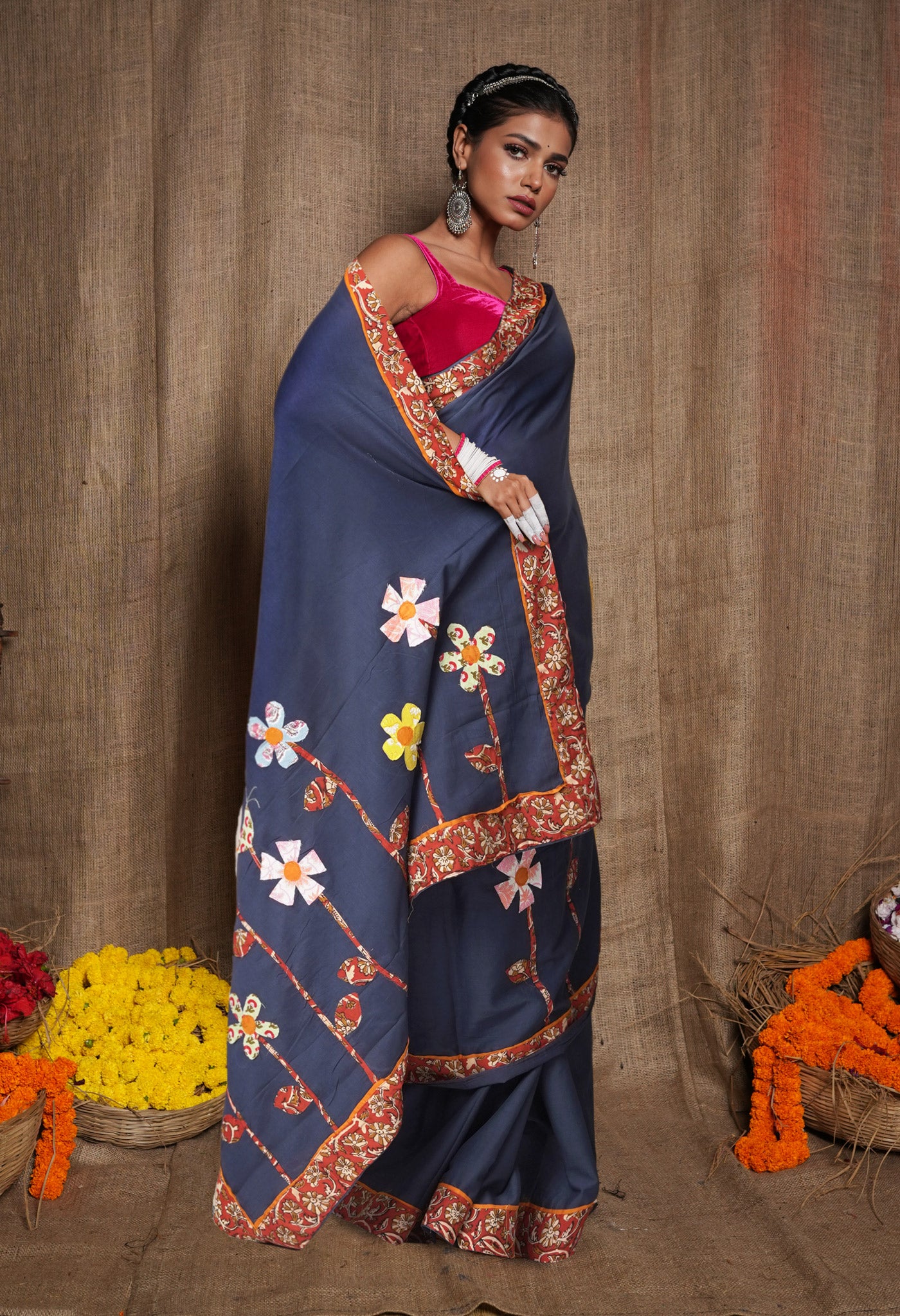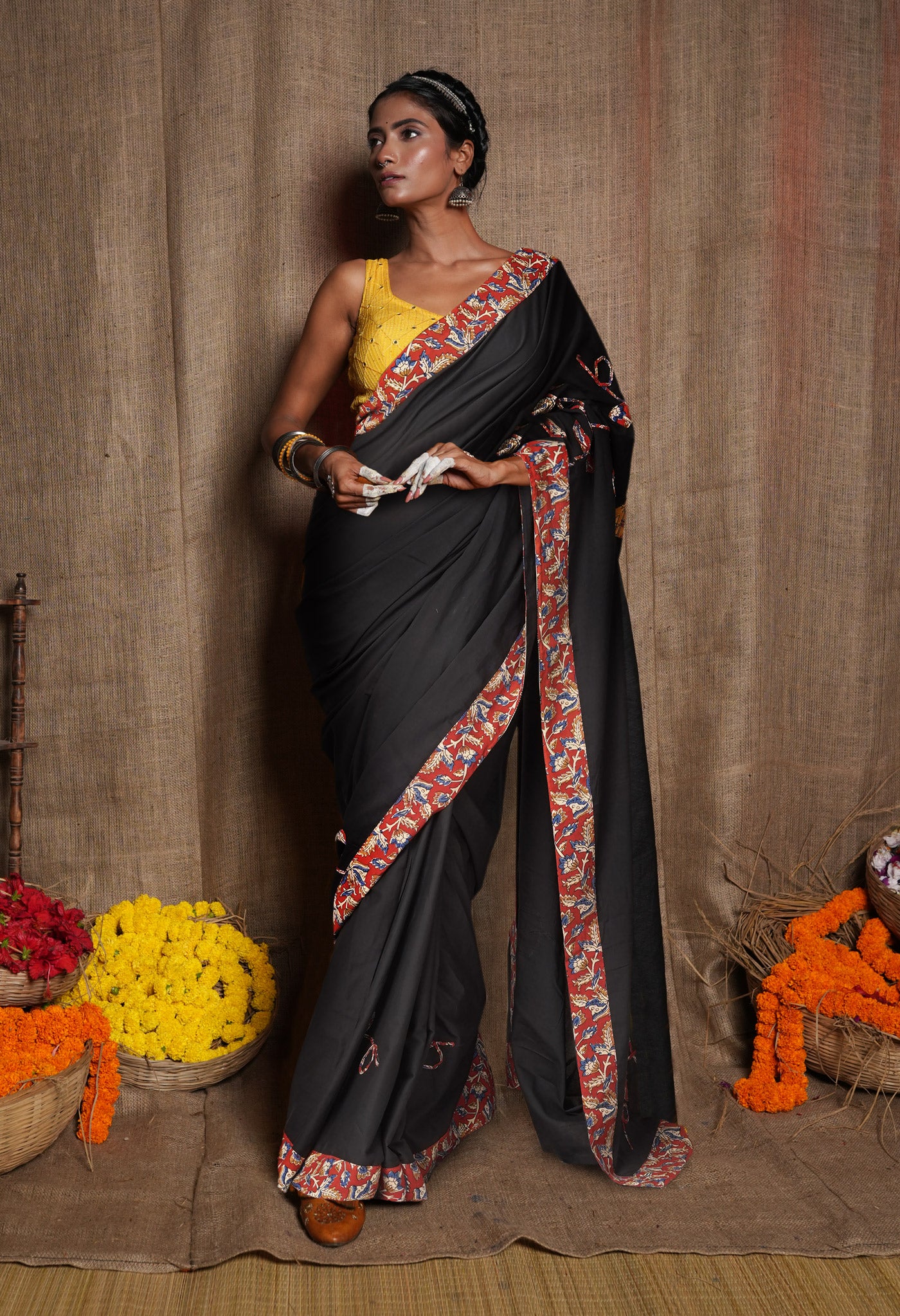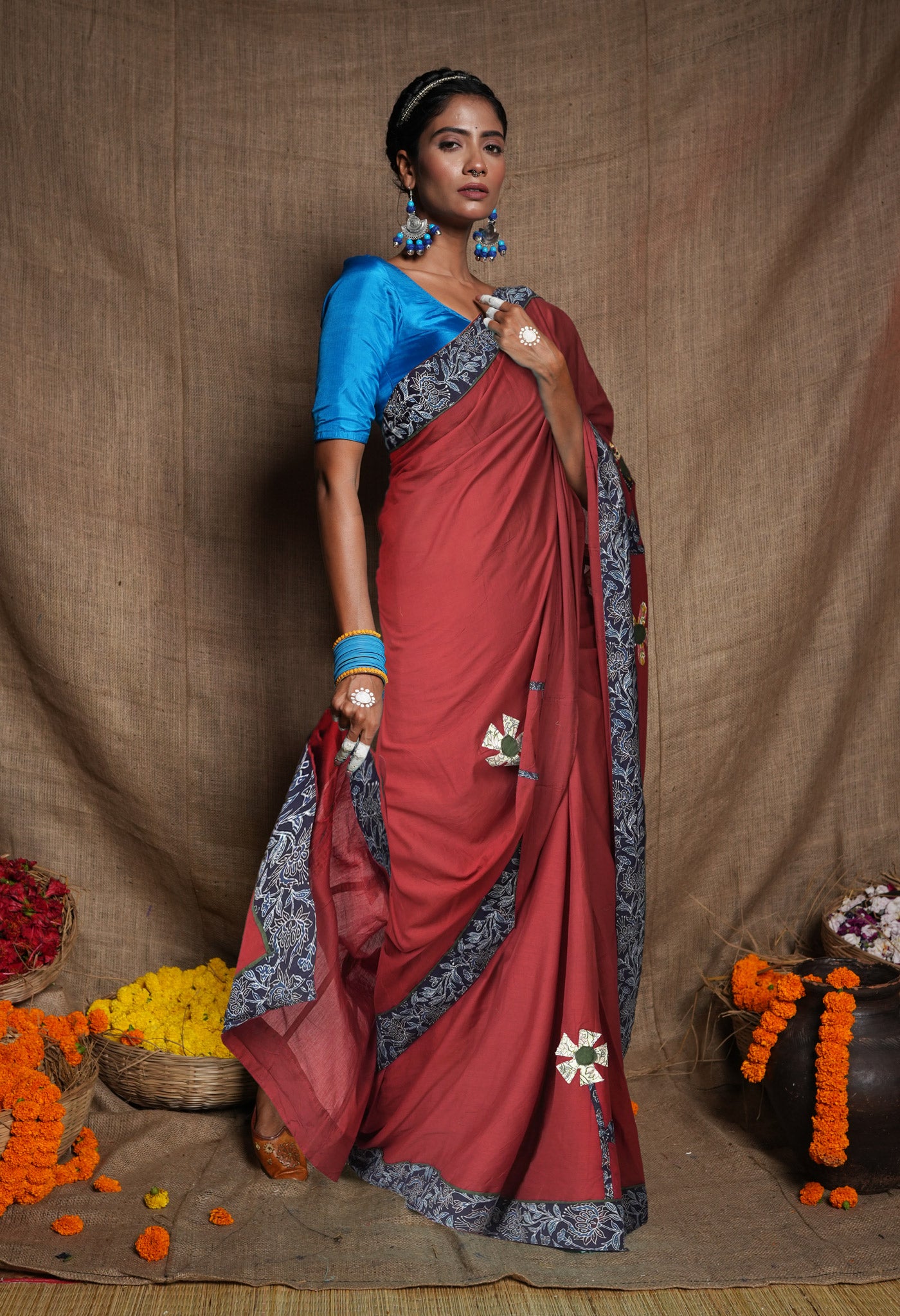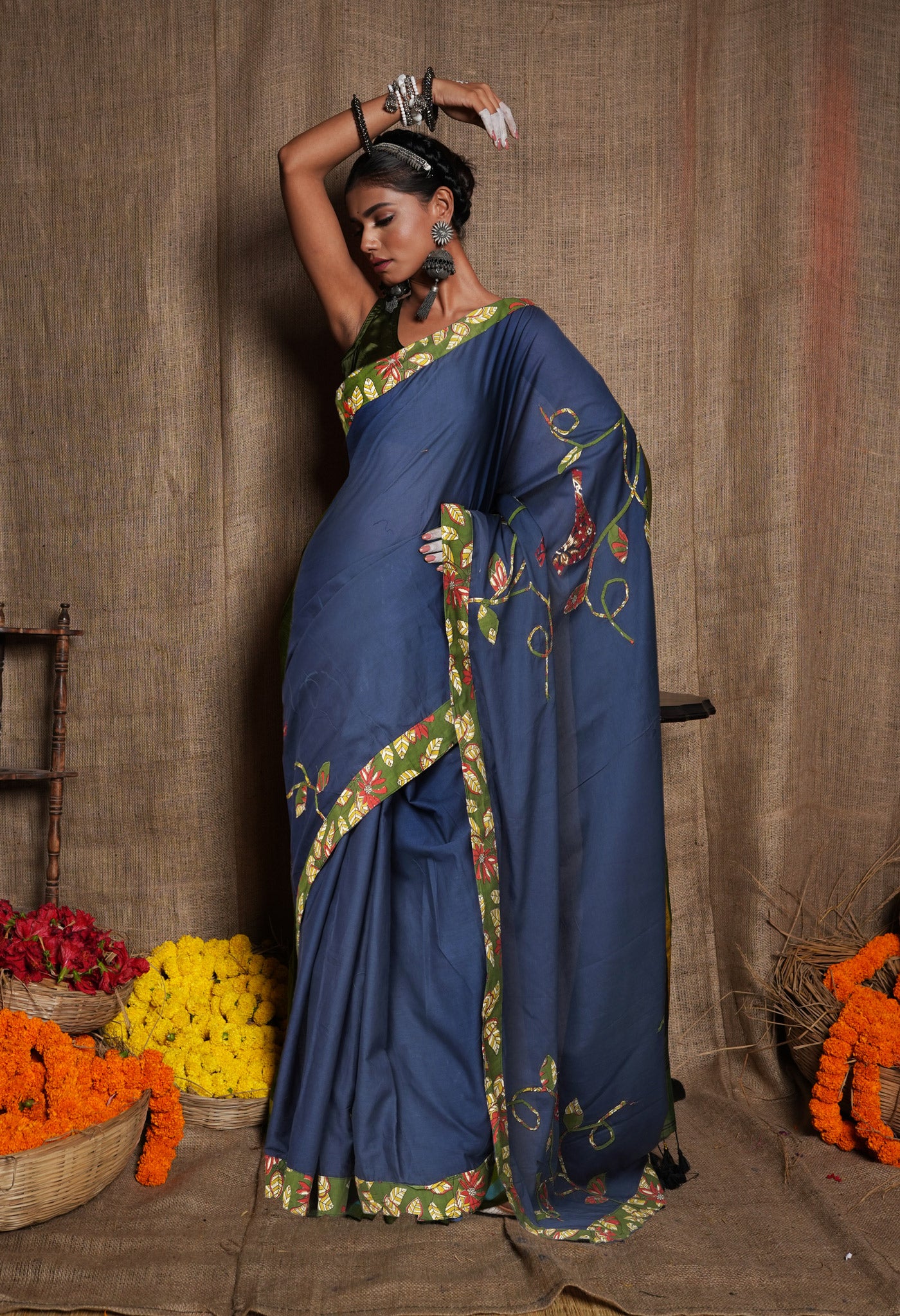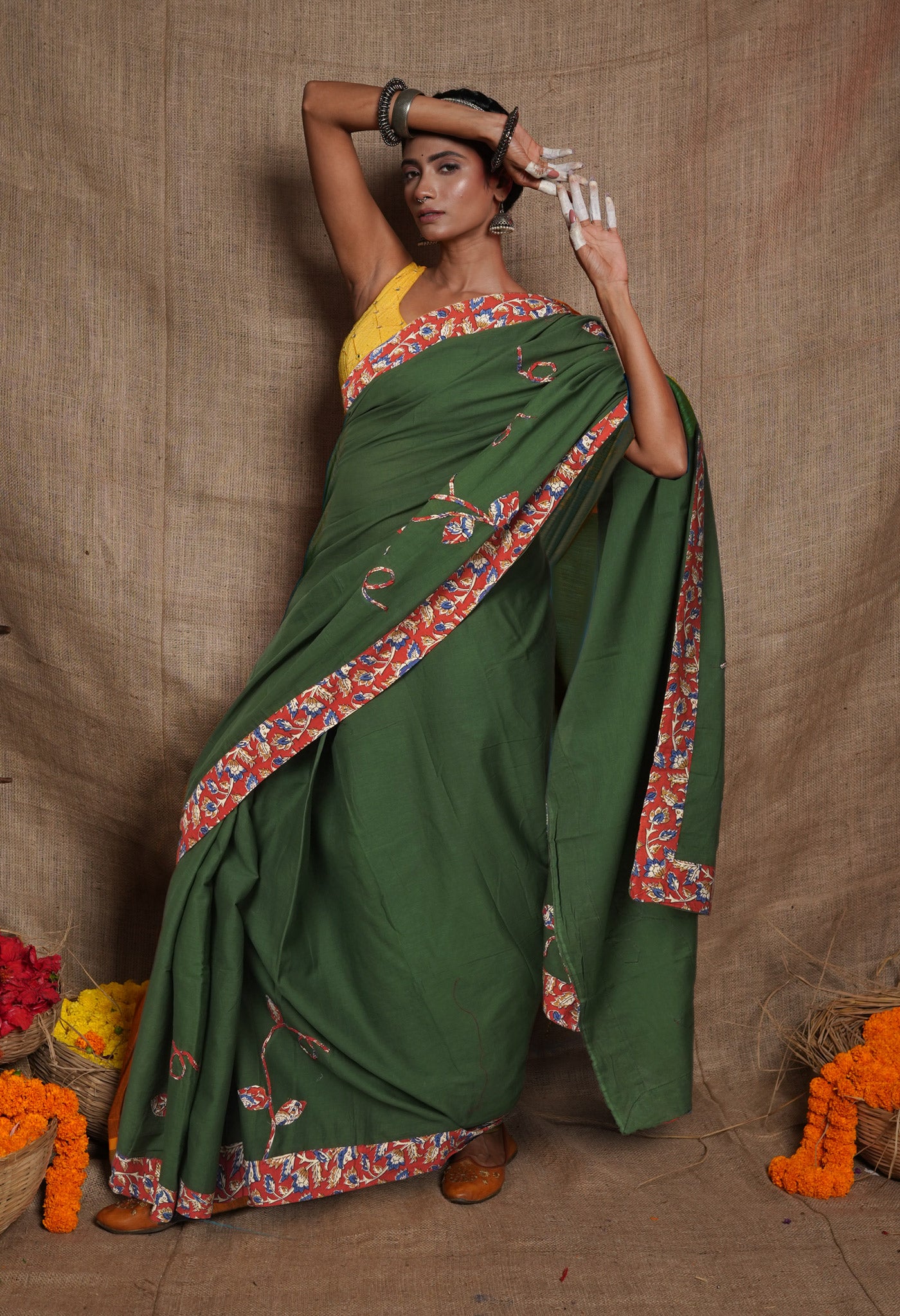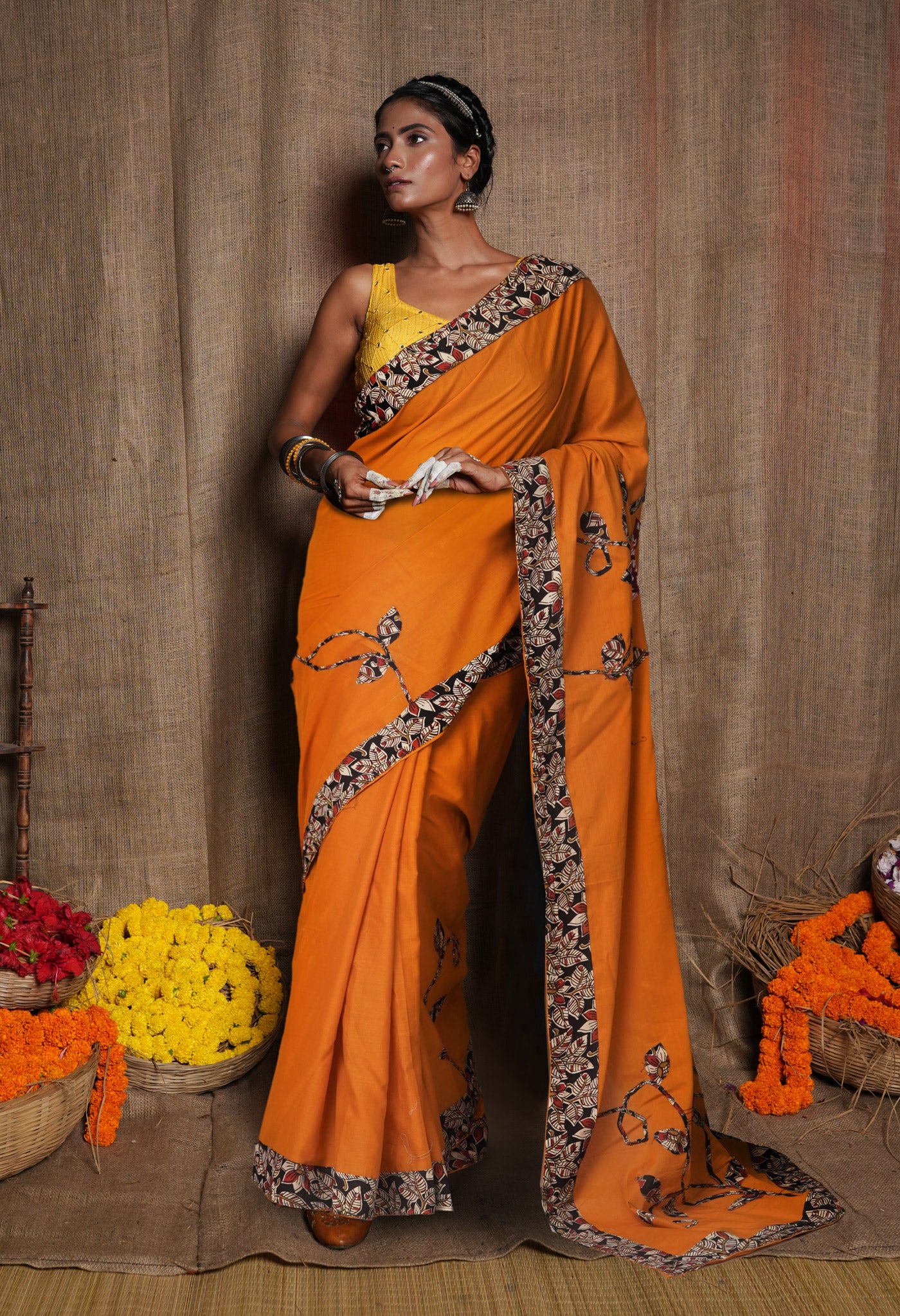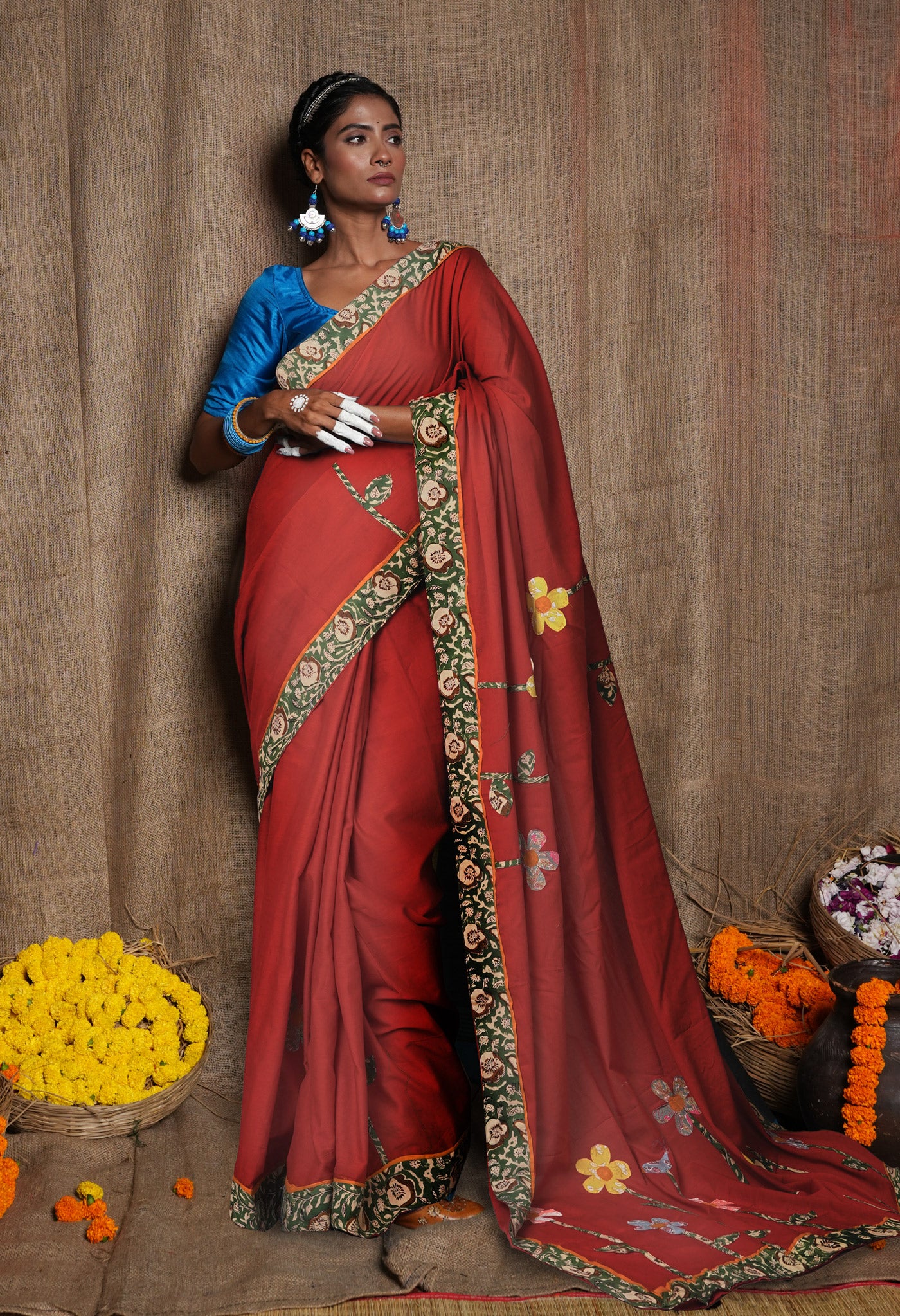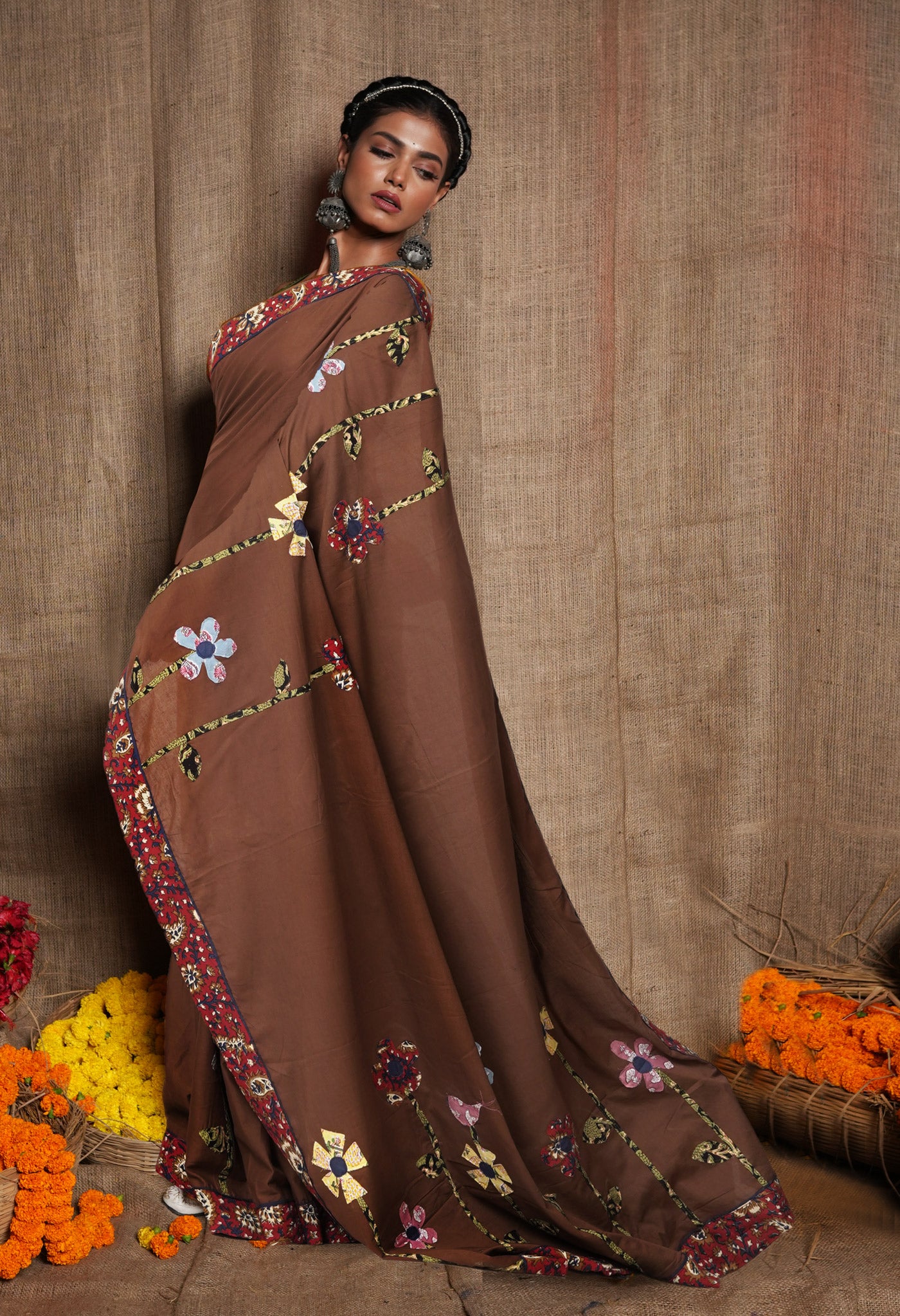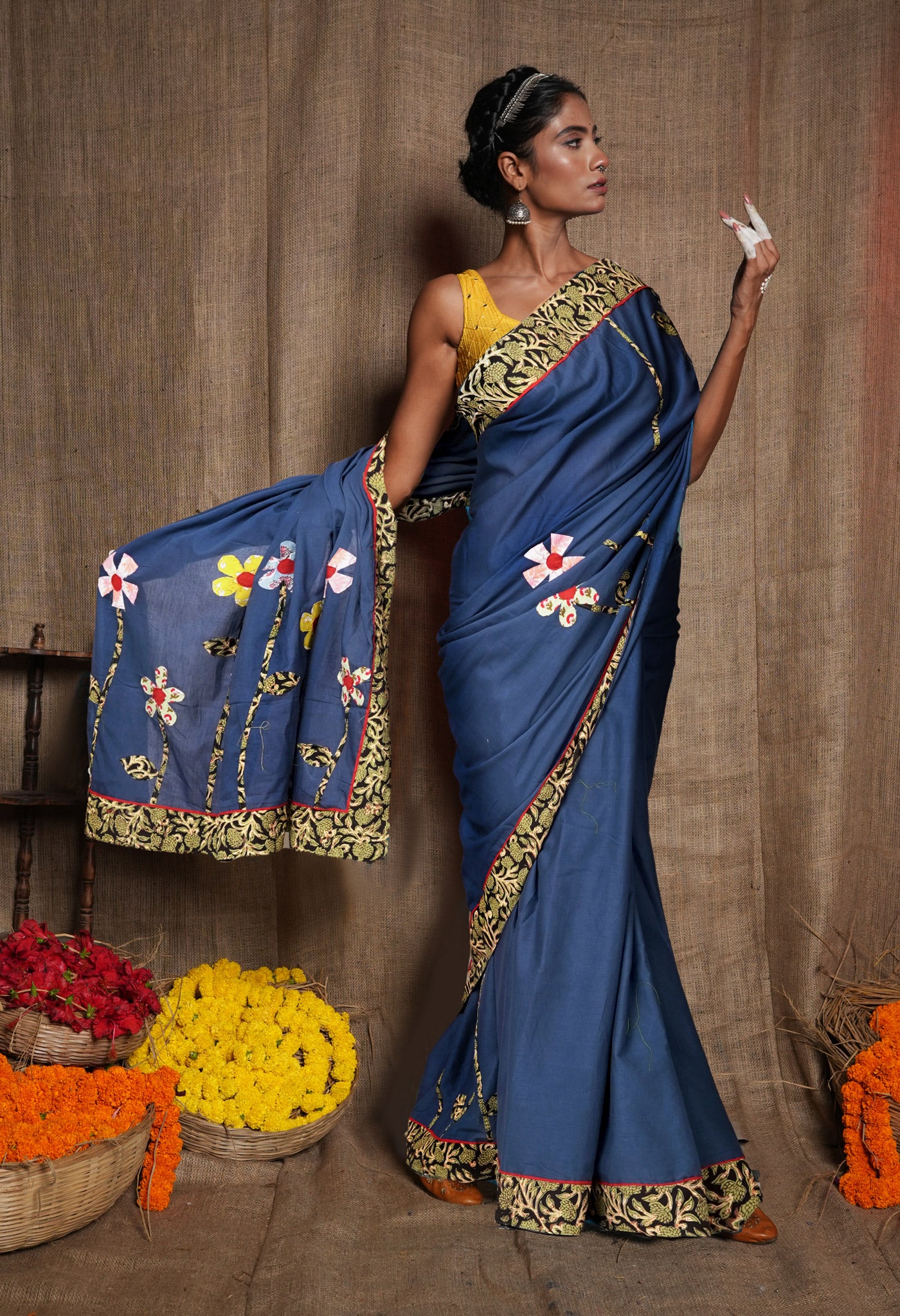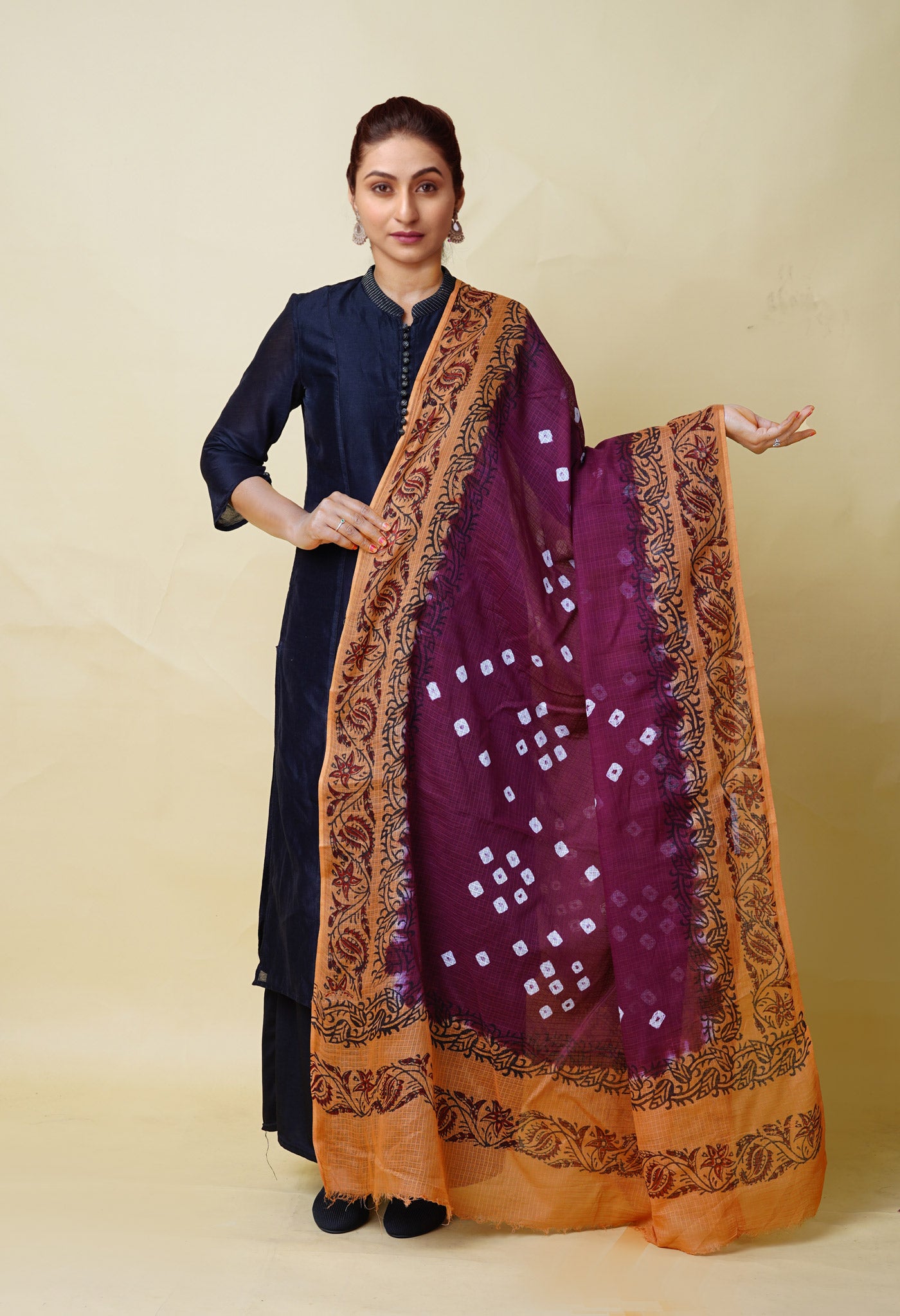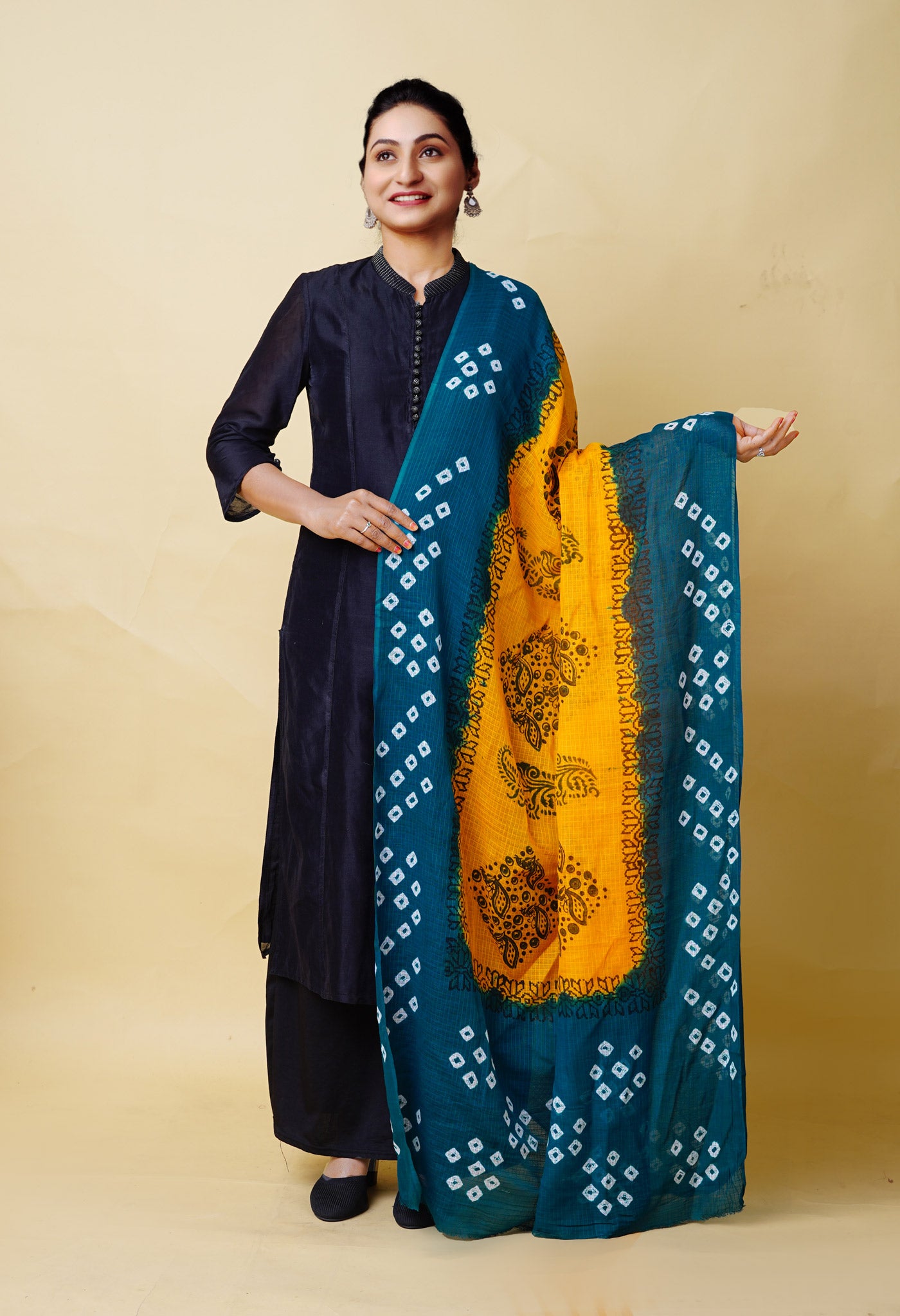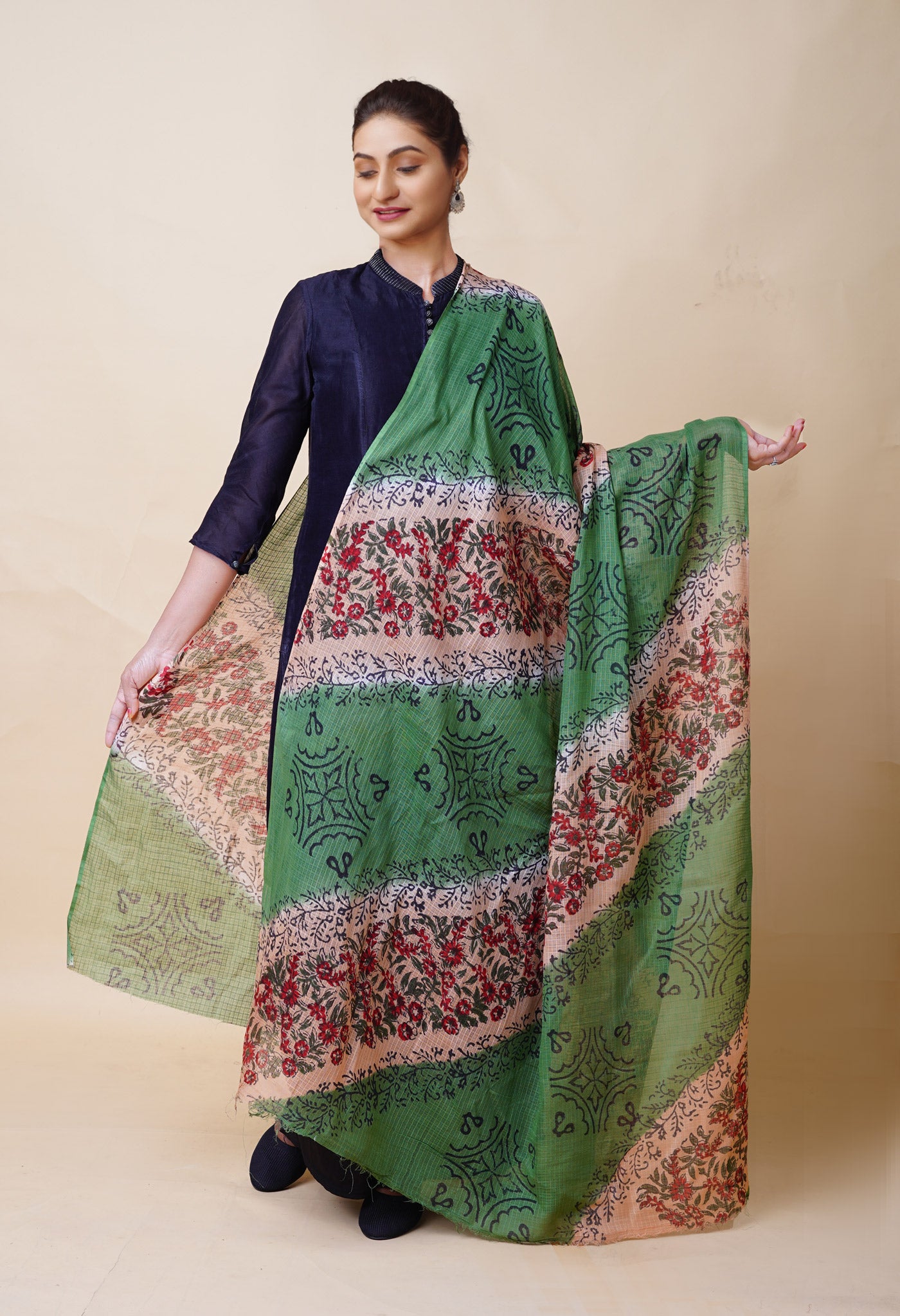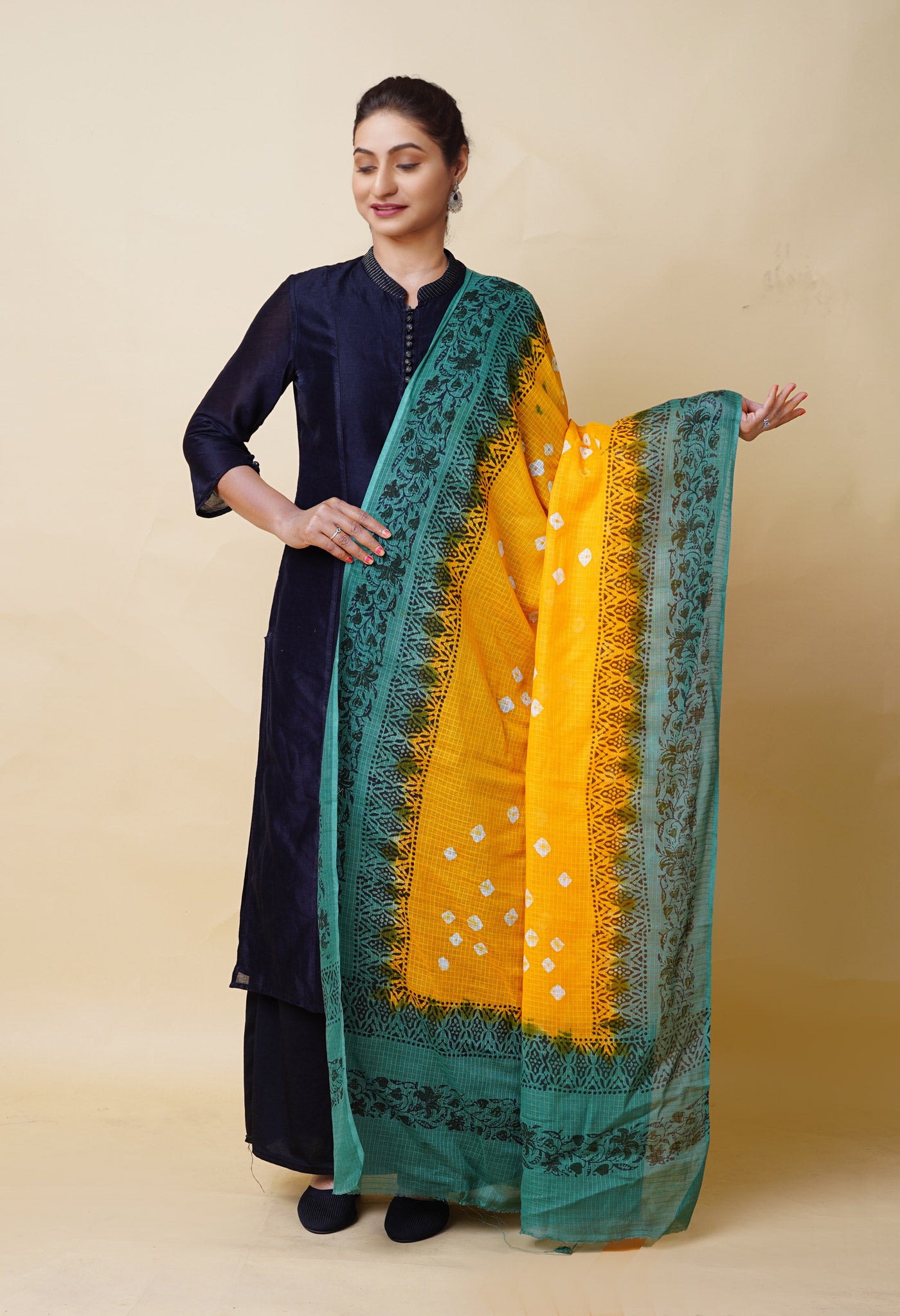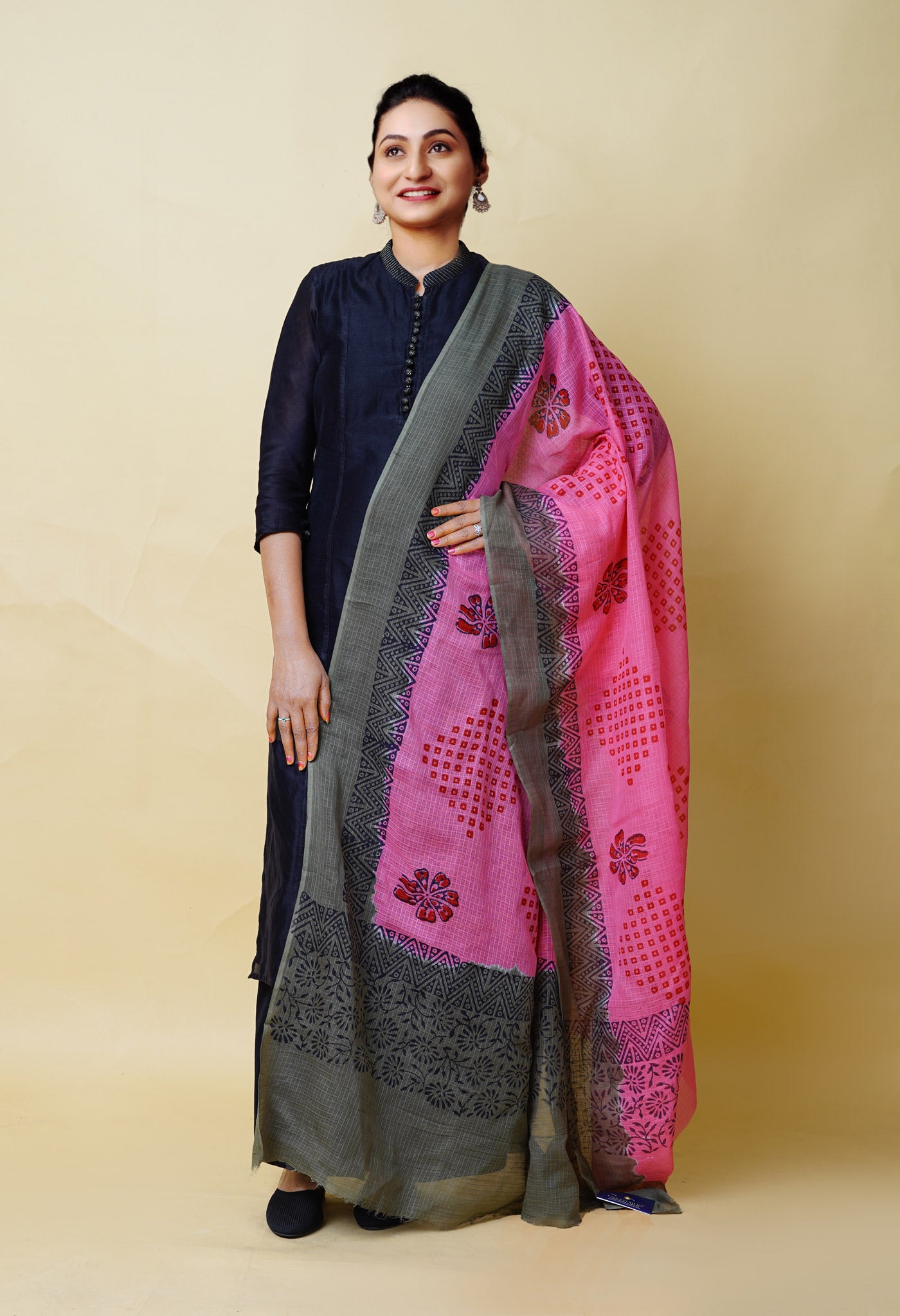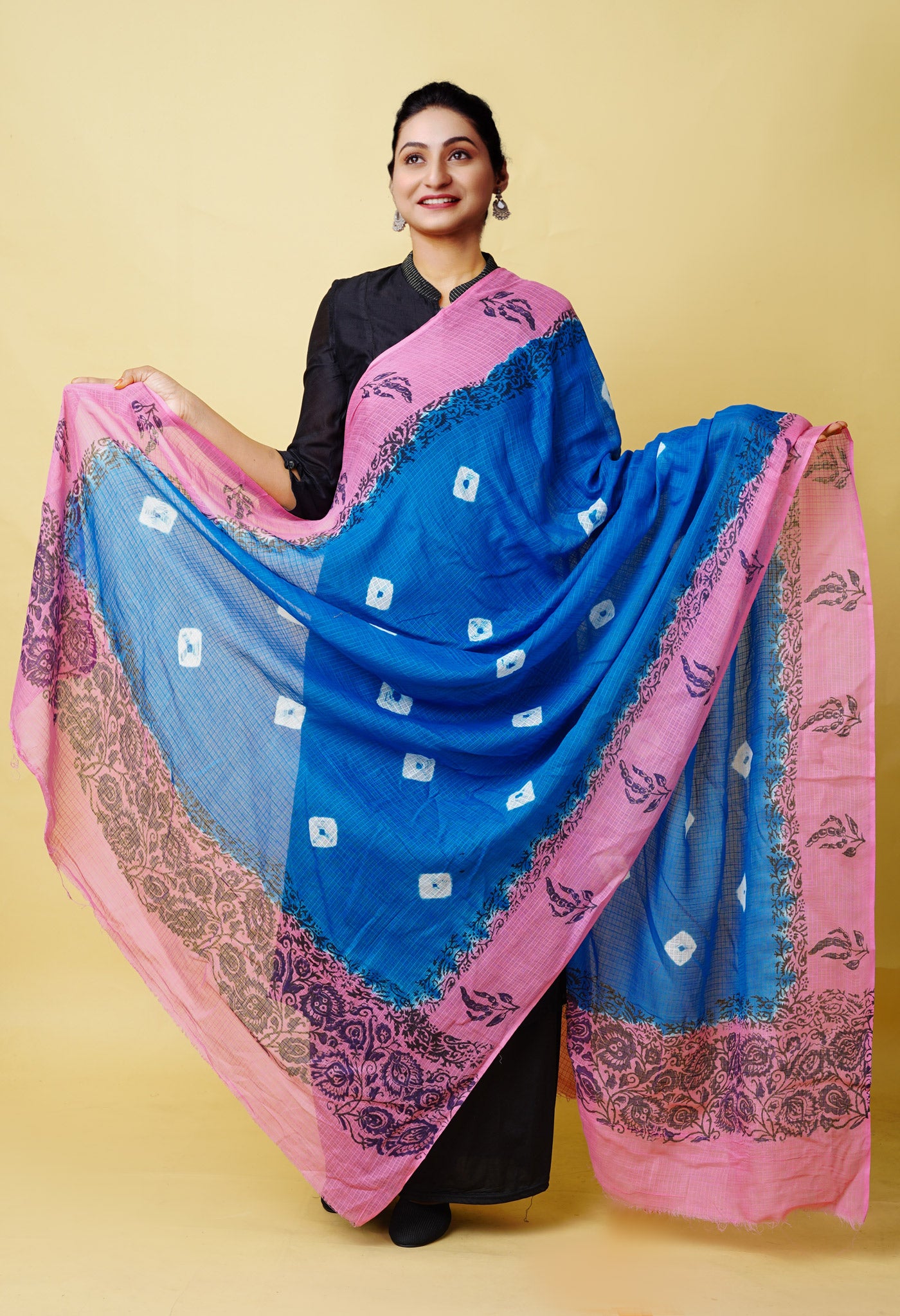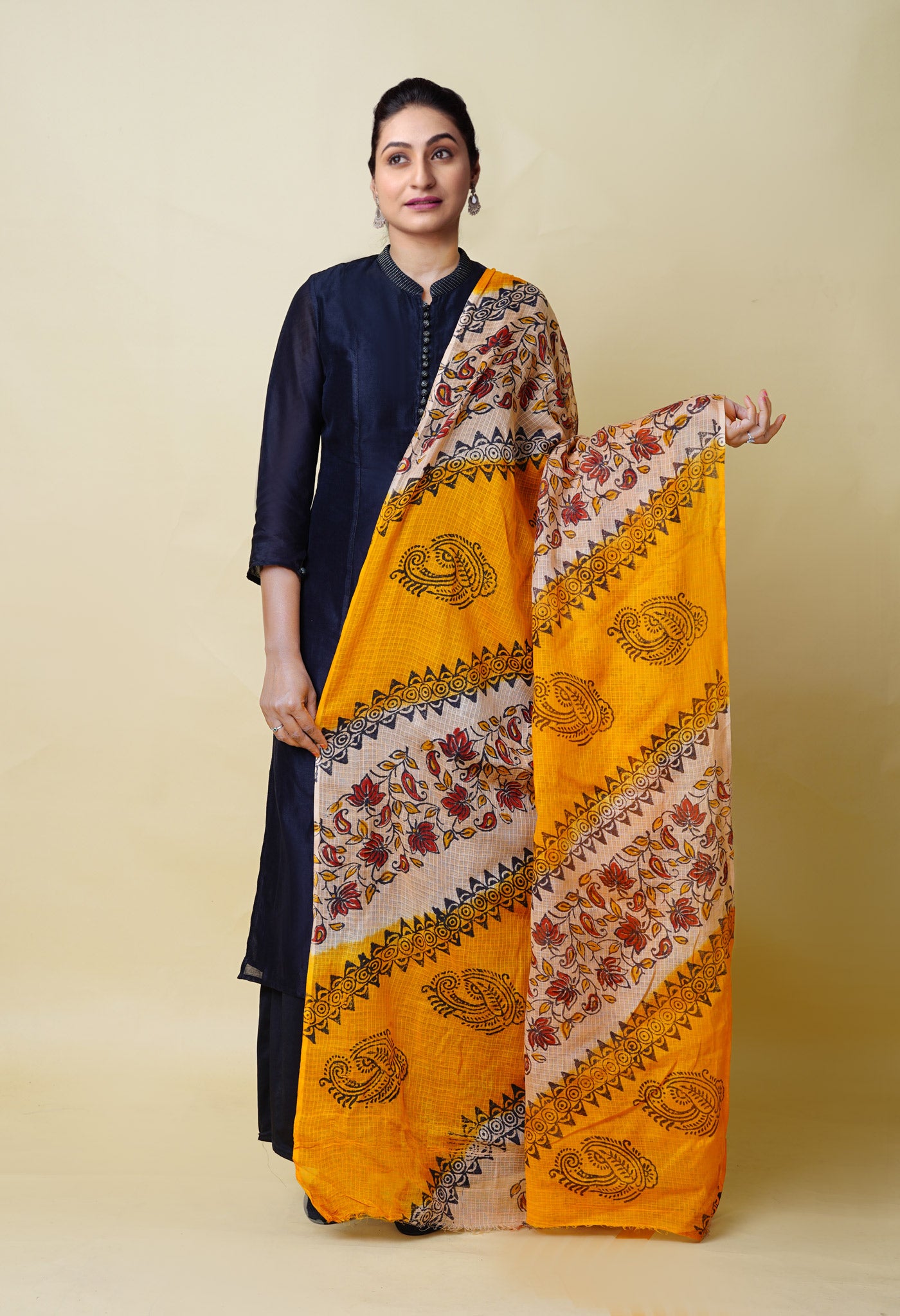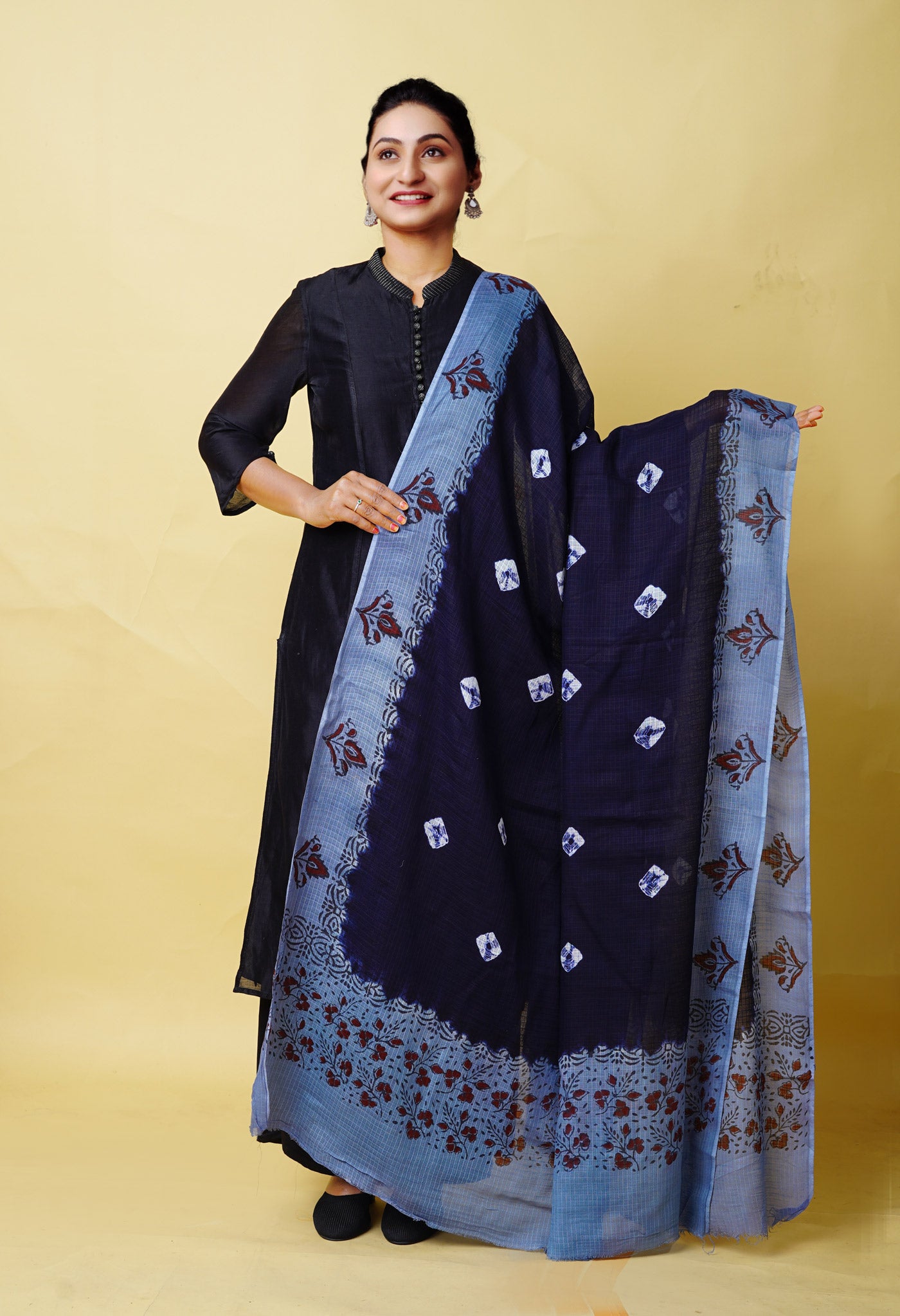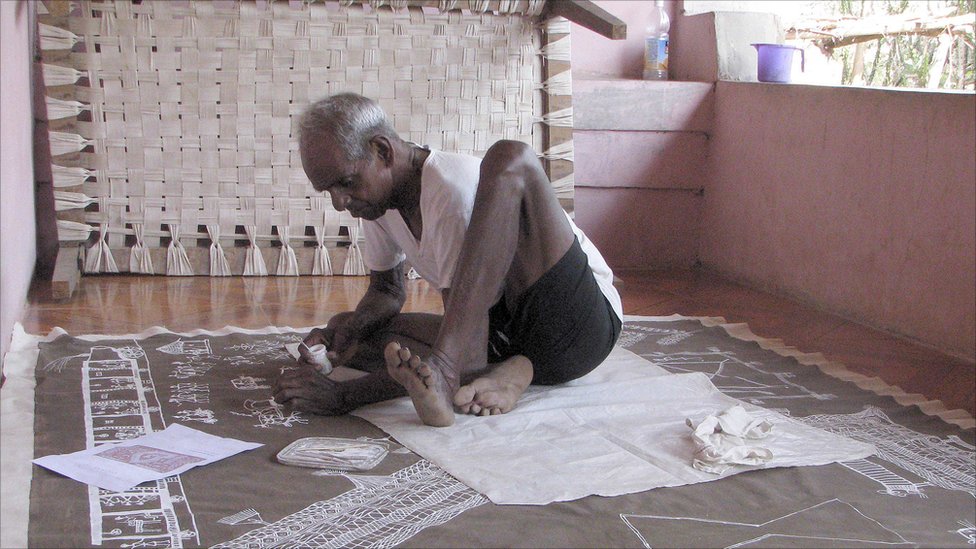
Warli Painting sarees – simple art striking portrayal
A peculiar and strange art but very unique in its character is the Warli Painting of Thane district, India. Folk art as it is known today, and brought onto fabrics by fashion designers, it is a creation of tribals found on the outskirts of Mumbai, mostly in the Thane district and its surrounding areas. The intended purpose for the drawings or paintings on mud walls, done mostly by women, was actually the transfer of folklore to successive generations. Today they are sensational depictions on the pallu or end piece of costly silk sarees.
Features of Warli Painting on walls
The traditional themes of Warli paintings depicted humans, animals, and scenes from daily life. The white depictions on red or brown coloured mud walls were simple drawings with profound themes portrayed. The paintings resembled pre-historic cave paintings in execution. Scenes of humans engaged in hunting, dancing, sowing and harvesting were generally chosen.  Warli painting was done on mud walls using only one color, white. Dots, lines and geometric patterns were mostly preferred, themes such as Pujas, special occasions, human tales and suffering being popular subjects. The appeal of Warli paintings lay in the simplicity and straightforward narrations. Warli paintings representing Palghat, the marriage god or the goddess of fertility, including horse carrying bride and groom were considered sacred.
Warli painting was done on mud walls using only one color, white. Dots, lines and geometric patterns were mostly preferred, themes such as Pujas, special occasions, human tales and suffering being popular subjects. The appeal of Warli paintings lay in the simplicity and straightforward narrations. Warli paintings representing Palghat, the marriage god or the goddess of fertility, including horse carrying bride and groom were considered sacred.
The ritual paintings were usually done inside the huts, the walls being made up of a mixture of branches, earth and cow dung, provided a red ochre background for the paintings in white. The Warli tribals used only white for their paintings. Their white pigment was a mixture of rice paste and water with gum as a binder. They used a bamboo stick chewed at the end to make it as supple as a paintbrush. The wall paintings were done only for special occasions such as weddings or harvests. The lack of regular artistic activity could be the reason for the very crude style of their paintings, which were the preserve of the womenfolk until the late 1970s.
The modern day Warli Painting
 In the 1970s this ritual art took a radical turn, when Jivya Soma Mashe and his son Balu Mashe started to paint, not for any special ritual, but because of his artistic pursuits. The painting is done today on an austere mud base using one color, white, with occasional dots in red and yellow. This colour is obtained from grounding rice into white powder. This sobriety is offset by the ebullience of their content. These paintings also serve social and religious aspirations of the local people. It is believed that these paintings invoke powers of the Gods. Geometric designs dominate most paintings; dots and crooked lines are the units of these compositions. The appeal of these uni-color compositions lies in their lack of pretentiousness in conveying the profound. The paintings are beautifully executed and resembles pre-historic cave paintings in execution and usually depict scenes of human figures engaged in activities like hunting, dancing, sowing and harvesting.
In the 1970s this ritual art took a radical turn, when Jivya Soma Mashe and his son Balu Mashe started to paint, not for any special ritual, but because of his artistic pursuits. The painting is done today on an austere mud base using one color, white, with occasional dots in red and yellow. This colour is obtained from grounding rice into white powder. This sobriety is offset by the ebullience of their content. These paintings also serve social and religious aspirations of the local people. It is believed that these paintings invoke powers of the Gods. Geometric designs dominate most paintings; dots and crooked lines are the units of these compositions. The appeal of these uni-color compositions lies in their lack of pretentiousness in conveying the profound. The paintings are beautifully executed and resembles pre-historic cave paintings in execution and usually depict scenes of human figures engaged in activities like hunting, dancing, sowing and harvesting.
Their extremely rudimentary wall paintings use a very basic graphic vocabulary: a circle, a triangle and a square. Their paintings are monosyllbic. The circle and triangle are from their observation of nature, the circle representing the sun and the moon, the triangle derived from mountains and pointed trees. Only the square seems to obey a different logic and seems to be a human invention, indicating a sacred enclosure or a piece of land.
The central motive in each ritual painting is the square, known as the "chauk" or "chaukat", mostly of two types: Devchauk and Lagnachauk. Inside a Devchauk, we find Palaghat, the mother goddess, symbolizing fertility. Significantly, male gods are unusual among the Warli and are frequently related to spirits which have taken human shape. The central motif in these ritual paintings is surrounded by scenes portraying hunting, fishing and farming, festivals and dances, trees and animals. Human and animal bodies are represented by two triangles joined at the tip; the upper triangle depicts the trunk and the lower triangle the pelvis. Their precarious equilibrium symbolizes the balance of the universe, and of the couple, and has the practical and amusing advantage of animating the bodies.
The whims and moods of tribal life make for interesting themes, which is why Warli Paintings are much more than designs on walls, they are authentic depictions of a way of life. Even today, it is a tradition with the tribals to decorate the mud walls of the huts with paintings made in rice paste.
[gallery columns="4" ids="13582,13583,13586,13584"]
Who are the Warli tribals?
The Warlis or Varlis are an indigenous tribe or Adivasis, living in the mountainous as well as coastal areas of Maharashtra-Gujarat border and surrounding areas. They have their own animistic beliefs, life, customs and traditions, and only when they came in contact with the locals there did they get to know and adopted many Hindu beliefs. The Warlis speak an unwritten Varli language which is a combination of several Indian languages and dialects .
Warli art is a beautiful folk art of Maharashtra, traditionally created by the tribal women. Tribals are the Warli, Malkhar Koli, Kathodi, Kokana, Dhodi tribes found on the northern outskirts of Mumbai, in Western India. This art was first explored in the early seventies & from then it was named as “Warli art”.
The tribals once forest-dwellers have made a gradual transition towards being a pastoral community. They reside in the West coast of Northern Maharastra. A large concentration is found in the Thane district, off Mumbai. A little backward economically, they still maintain their indigenous customs and traditions. The growing popularity and commercialisation of the Warli painting has seen the uplift of many tribals and they are increasingly becoming integrated with the mainstream. Their marriage traditions are unique to their culture.
Warli paintings were mainly done by the women folk. The most important aspect of the painting is that it does not depict mythological characters or images of deities, but depict social life. Pictures of human beings and animals, along with scenes from daily life are created in a loose rhythmic pattern.
folk. The most important aspect of the painting is that it does not depict mythological characters or images of deities, but depict social life. Pictures of human beings and animals, along with scenes from daily life are created in a loose rhythmic pattern.
India has a rich tradition of folk arts the custodians of which are the many tribes that live in the interiors of various states. Today this art has also been transferred to a popular canvas, the saree, which is both a traditional attire and a national heritage.
Tribal people express themselves in vivid styles through paintings which they execute on the walls of their house. This was the only means of transmitting folklore to a populace not acquainted with the written word.
Modern Day Warli art
The painting on paper is a fall-out of commercialisation. The tribals indulge in this activity during festivals, on community occasions such as harvesting or rituals such as weddings. They draw inspiration from everyday lives for their themes.
Thus, a typical Warli painting will have a village landscape with farms, trees and domestic animals. Farmers cultivating land and marriage ceremonies are other oft-repeated themes. Nowadays, these paintings are made on hand-made paper, usually green or brown, the colour of mud-walls with or without the cow-dung, with white paint. The paintings are simple line drawings, mere outlines with little or no detailing. The human figures in a Warli painting are simple, yet stylish - easy even for a child to master.
Everyday themes would have traditionally farm scenes with huts, with off-late modern elements having started creeping in. Cityscapes with its vehicles, schools and other contemporary themes are making way to keep pace with the world outside their community - a bit of a sell-out to draw attention, possibly. But largely, these paintings with traditional themes are still a big draw, both domestically and internationally.
[/vc_column_text][/vc_column][/vc_row][vc_row][vc_column][vc_video link="https://www.youtube.com/watch?v=JZ_GaJ9xiZg"][/vc_column][/vc_row][vc_row][vc_column][vc_column_text]The rich collection of Warli sarees at Unnati Silks
Warli painted sarees form an exclusive range and experimented successfully on different fabrics. You have the Orissa Sico and the Jute cotton sarees, the fine Kerala cottons, the pure Tussar silks, the ghicha jute tussar silks and others. Each has the typical Warli painting features of figurines in themes of marriage, procession, dancing, flora, fauna, nature themes and the like that are so clearly outlined in detail and sharply. It is a credit to the ethnic artisans that the Warli painting is reproduced verbatim and in pleasant hues.
[/vc_column_text][/vc_column][/vc_row][vc_row][vc_column][vc_gallery type="image_grid" images="13597,13605,13601,13614,13604,13608" img_size="medium"][/vc_column][/vc_row][vc_row][vc_column][vc_column_text]
Talent or skill knows no boundaries and is found equally in the uneducated tribal’s abode where it is nurtured generation after generation or in the workshops of fashion where skills are taught and it is cultivated. Warli painting is an art that is unique, creative, inspirational and needs that all paintingsencouragement from a market to applaud the enthusiasm and dedication in the offerings.
[/vc_column_text][/vc_column][/vc_row][vc_row][vc_column][vc_btn title="Shop online for Warli Painting Sarees" color="turquoise" link="url:http%3A%2F%2Fwww.unnatisilks.com%2Fsarees-online%2Fby-work-sarees%2Fwarli-painting-sarees.html||target:%20_blank"][/vc_column][/vc_row]

